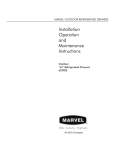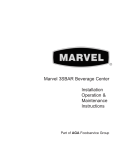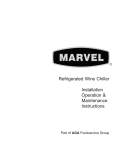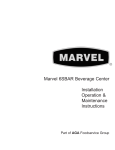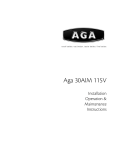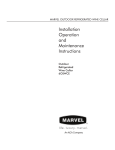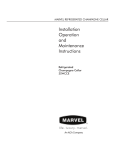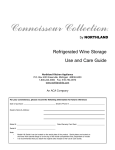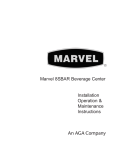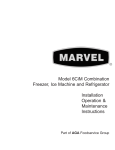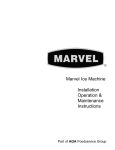Download Aga Ranges ACIM-15 User's Manual
Transcript
Aga ACIM-15 For models with serial number 20070608001 and higher S TA RT I N G O U T Remove Packaging Your ice machine has been packed for shipment with all parts that could be damaged by movement securely fastened. Before installing the ice machine, be sure all packing materials and tape have been removed. Important Save the carton packaging until your ice machine has been thoroughly inspected and found to be in good condition. If there is damage, the packaging will be needed as proof of damage sustained in transit. Note to Customer This ice machine was carefully packed and thoroughly inspected before leaving our plant. Responsibility for its safe delivery was assumed by the carrier upon acceptance of the shipment. As directed on the side of the packaging carton, claims for loss or damage sustained in transit must be made on the carrier as follows: Exterior Damage Make a thorough damage notation on the delivery receipt and have the driver acknowledge by signing and dating. Send a written request to the carrier asking for an inspection report from the carrier representative and the date the inspection was requested. Retain the inspection report and receipt for filing of a claim. Concealed Damage This must be reported to the carrier within fifteen days. Obtain an inspection report from the carrier. Retain the inspection report for filing of the claim. DO NOT RETURN DAMAGED MERCHANDISE TO THE MANUFACTURER - FILE THE CLAIM WITH THE CARRIER. 3 I N S TA L L AT I O N : D R A I N P L U M B I N G Drain Plumbing Your ice machine uses a gravity drain, (figure 1) that requires 5/8" I.D. tubing from the back of the ice machine to a plumbed connection to a sanitary sewer. Remove the access panel to plumb in drain connection. Gravity drain location for built-in units can be within the area shown in figure 3. An optional drain pump, (figure 2) can be purchased for your ice machine if a gravity drain is not accessible. OBSERVE AND FOLLOW ALL LOCAL CODES WHEN INSTALLING ICE MACHINE. figure 1 FAILURE TO USE ADEQUATE DRAINAGE SYSTEM WILL RESULT IN SURROUNDING WATER DAMAGE AND/OR POOR ICE PRODUCTION. figure 2 figure 3 Gravity Drain Location * With optional filler kit 5 WAT E R S U P P LY Water Supply This ice machine must be connected to a potable, active cold water supply line delivering water pressure at a minimum of 20 psi and maximum of 120 psi. • Water connection is made through a right angle garden hose fitting supplied with ice machine. See garden hose fitting for detailed instruction sheet. Do not use any thread sealers. • A water filter can be used with this unit. A quality filter can help remove particles as well as remove taste and odors from water. • Do not use a “reverse osmosis” filtering device. • Softened water is not recommended. This will produce soft, cloudy ice cubes that will stick together. • De-ionized water is not recommended. This water will not form solid ice cubes. • A water specialist can recommend proper water treatment. • After installation of water line, turn on water and check for any leaks. Additional tightening may be needed. • Allow for extra water line for built-in installations for easy removal of unit and to help prevent the water line from kinking. Operation Your ice machine is unique in forming ice. It uses fractional freezing to form a slab of ice that is clear and has less mineral content than the water it is produced from. This is accomplished by running water over the cold evaporator plate which gradually freezes the water to produce the ice slab. Mineral deposits are left in the reservoir. squares by the grid cutter's heated wires. During the harvest cycle, the drain valve will remain open for 45 seconds to drain the reservoir of remaining deposits. After that, the water valve open will open for 2 minutes providing 2 quarts of water to the reservoir for the next ice production cycle. The ice machine will keep producing ice until the ice machine's bin is full and will restart automatically when ice needs to be replenished in the bin. When the ice slab reaches the correct thickness determined by the temperature of the evaporator plate, the electronic control switches to the harvest cycle to harvest the ice. During the harvest cycle, the ice slab falls from the evaporator to the ice grid cutter. Here, the ice slab is cut into 3/4" 6 CARE OF THE UNIT Care of Unit 1. Avoid leaning on the cabinet door. You may bend the door hinge or tip the unit. 2. Exercise caution when sweeping, vacuuming, or mopping near the front of the unit. Damage to the grille and/or switch can occur. 3. Periodically clean the inside of the ice machine components and inside of unit (see Cleaning Your Ice Machine section). 4. Periodically check and/or clean the front grille and condenser coils as needed. 5. If your ice machine has either a stainless steel door and/or cabinet, to keep it looking its best, we recommend periodically applying a stainless steel cleaner and a non-abrasive stainless steel polish. This is especially important for outdoor applications and locations near saltwater environments. Normal Responsibilities of the Owner • All freight charges • Damage sustained in transit • Mileage charge(s) for service calls • Proper installation including installation of leveling legs. • Leveling of unit. • Alterations to original equipment • Removal or installation of additional equipment (i.e. drain pump). • Cleaning and normal maintenance outlined in this manual. • Drain and water supply plumbing to the ice machine. Help Prevent Tragedies Each year, children die because they climb inside a discarded refrigeration product, get trapped inside and suffocate. Take precautions to prevent such tragedies by removing the door, taping or chaining it shut before discarding. 7 CARING FOR YOUR ICE MACHINE Cleaning Your Ice Machine Some impurities will remain and build up in the ice machine and stick to the ice machine's parts over time. This build-up must be removed for proper ice production, ice quality, and ice machine life. Your ice machine is equipped with a cleaning mode that will help in cleaning out these impurities. 7. After the cleaning cycle has ended, remove the front panel again and check that the build-up has been removed. The evaporator plate should be clean, shiny, and smooth to the touch. If build-up is still visible, repeat the cleaning cycle above. If build-up is removed, continue below. The impurities will need to be cleaned of this buildup regularly (at the very least, annually), depending on use and water hardness. You can use an acid such as one specified for ice machine cleaning or you can use citric acid to remove the buildup. To clean the ice machine: 8. Remove the distributor tube, hose clamp, hose and its rubber ends. 9. Thoroughly clean the inside of the distributor tube and the spray holes. You can use the same cleaning solution as before and an old toothbrush to reach the inside of the distributor tube. 10. Reinstall the rubber ends, hose, and hose clamp to the distributor and then reinstall the distributor tube to the evaporator with the spray holes pointed to the bottom of the evaporator plate. Reinstall the front cover panel with the two front panel screws. 11. Clean the ice machine's interior, ice scoop, interior door panel and door gasket with mild soap and water. Using two tablespoons of baking soda in one quart of warm water while cleaning will help remove odors. Rinse with fresh water. Do not use any abrasive cleaning products. 1. Switch the selector switch to the "OFF" position. 2. Remove the drain plug at the bottom of the reservoir to drain any remaining water and then reinstall. 3. Add the recommend cleaner solution to the reservoir of the ice machine. Access to the reservoir can be obtained by removing the front panel screws and the front panel. Determine the proper amount of cleaner from the ice machine cleaner manufacturer's mixture ratio based on 3 quarts of water (refer to manufacturer's directions). 4. Replace the front cover panel and close the door. 5. Switch the selector switch on the grille of the ice machine to the clean position. Three quarts of water will automatically be added to the cleaning solution. Read manufacturer's warnings on ice machine cleaner products. Personal injury can result. 6. Your ice machine is now clean and sanitized and may be put back into operation by switching the selector switch to the "ON" position. The total cleaning time will end in 49 minutes. The cleaning cycle will automatically rinse the evaporator plate and also drain the cleaning solution and rinse water. 8 T H I N G S TO R E M E M B E R Things to Remember • Allow your ice machine to run for 24-48 hours to accumulate ice in ice machine's bin. • Keep your ice machine clean for proper ice quality, production, and unit life. • Room and water temperatures will greatly affect the output of ice in your unit (see table). Ice will also melt away, especially at the start of an empty bin, but will slow down as ice accumulates. 9 50 70 70 34 32 80 30 27 90 23 20 WATER TEMPERATURE °F ROOM TEMPERATURE °F • Unplug your ice machine before working on unit. WATER TEMPERATURE °F ROOM TEMPERATURE °F • Your unit will automatically shut down when the ice bin is full. APPROXIMATE TIME TO FILL BIN (HOURS)* PRODUCTION RATE (LB/DAY)* • Unit will cycle often between ice production and ice harvest cycles. 50 70 70 31 34 80 41 58 90 60 82 *NOTE: DUE TO VARIABLES IN INSTALLATION AND USE, INDIVIDUAL RESULTS MAY VARY. O B TA I N I N G S E RV I C E Before Calling for Service Before calling for service, check the following items: • Make sure unit is plugged into outlet. • Check the outlet for power. Test outlet with lamp to make certain outlet has power. • Make sure ice machine's switch is in the "ON" position. • Make sure that there is cold water supplied to the ice machine. • Make sure drain plug on bottom of reservoir is inserted. • Make certain unit is level from front to back and side to side. • Make certain that the drain line to the ice machine is not restricted or kinked. • Use troubleshooting guide, pages 13-16 for other diagnosis. If you are not able to correct the problem, contact your dealer or the manufacturer. Be sure to have the model number and the serial number handy before you call. The model and the serial number are located on the lower front part of the ice machine's cabinet. How to Obtain Service Your ice machine requires little service because the best and most up-to-date materials, equipment and quality control methods are employed throughout the manufacturing process. 2. If the product is outside of the first year warranty period, Marvel Customer Service can provide recommendations of service centers in your area. A listing of authorized service centers is also available at www.marvelindustries.com under the service and support option. 3. In all correspondence regarding service, be sure to give the model number, serial number and proof of purchase. 4. Try to have information or description of the nature of the problem, how long the unit has been running, the room temperature, water temperatures, and any additional information that may be helpful in quickly solving the problem. SEND IN YOUR WARRANTY RECORD CARD IMMEDIATELY AFTER TAKING DELIVERY OF YOUR ICE MACHINE. Every new ice machine that leaves the factory contains this Owner's Guide. Keep this Owner's Guide in a safe place for convenient reference. For Your Records Date of Purchase Dealer's Name Dealer's Address If trouble occurs during normal operation, read "Things to remember" section first and, if necessary, check the troubleshooting guide. If service becomes necessary: 1. If the product is within the first year warranty period, please call Marvel Customer Service at 800-428-6644 for directions on how to obtain warranty coverage in your area. Dealer's city Appliance Serial Number Model Number Date Warranty Card Mailed (within 10 days of purchase) 11 Dealer's State Zip TROUBLESHOOTING ONE PROBLEM POSSIBLE CAUSE CORRECTION Unit does not operate. The unit is unplugged. Breaker is tripped or fuse is blown. Plug in the unit. Reset breaker or replace fuse. Check to make sure there is not a short in the electrical circuit. Set the rocker switch on the grille of the ice machine to the "ON" position. Ice machine selector switch is in the "OFF" position. Unit operates but does not produce any ice. The unit has just been started and it has been less than 6 hours. Typical ice production cycle can take up to 1.5 hours. Initial startup cycles can be longer. The selector switch is in the "OFF" or "CLEAN" position. No water in the reservoir. Distributor tube is restricted. Build up of deposits on evaporator plate. Condenser fan air flow is restricted. Room and/or water temperature is too warm. Leaking drain valve. Inadequate drain system. Grid cutter is unplugged. Circulation pump is unplugged. 13 Ice produced when the unit is initially started will melt off in the bin. Ice will accumulate in the bin. In 6 hours there can be a few cubes in the bin. This is normal operation. Check the unit in 24 hours for ice accumulation in the bin. Set the rocker switch on the grille of the ice machine to the "ON" position. Make sure that the reservoir drain plug is installed. Check the water line to the unit to make sure it is on and that there are no restrictions or kinks in the line. Check all filters to make sure they are not restricted or plugged. See "CLEANING YOUR ICE MACHINE" section for cleaning the unit for proper operation. See "CLEANING YOUR ICE MACHINE" section for cleaning the unit for proper operation. Make certain the grille in the front of the unit is free and open for proper air circulation. Check and clean the condenser coil by removing the grille in the front of the unit. Clean the condenser with a vacuum and brush attachment. Move the unit to an area where ambient temperature is below 90°. F. The unit should not be placed next to a heat source such as an oven. Check for cold water connection. See "CLEANING YOUR ICE MACHINE" section for cleaning the unit. This will also dissolve and flush out foreign material in the drain valve causing it to leak. Restriction in drain lines will cause ice in the bin to melt. If using a gravity drain, make certain there are no kinks or restrictions in the drain lines. If using a drain pump, check the inlet screen, discharge line, and vent line for any build or restrictions. Plug in the grid cutter so that ice slabs can be cut into cube. Plug in the circulation pump so that water from the reservoir can be circulated over the evaporation plate. TROUBLESHOOTING TWO PROBLEM POSSIBLE CAUSE CORRECTION Ice cubes are too small (less than 1/2 inch thick). Low ice consumption. Ice is slowly melting in the ice bin and will affect the size of the ice cube. This is normal operation. When the ice bin needs to be replenished, cubes will return to regular size. Make sure that the reservoir drain plug is installed properly. Check the water line to the unit to make sure there are no restrictions or kinks in the line. Check all filters to make sure they are not restricted or plugged. See "CLEANING YOUR ICE MACHINE" section for cleaning the unit for proper operation. See "CLEANING YOUR ICE MACHINE" section for cleaning the unit for proper operation and cube size. Restriction in drain lines will cause ice in the bin to melt to a thinner cube. If using a gravity drain, make certain there are no kinks or restrictions in the drain lines. If using a drain pump, check the inlet screen, discharge line, and vent line for any build-up or restrictions. See "CLEANING YOUR ICE MACHINE" section for cleaning the unit. This will also dissolve and flush out foreign material in the drain valve causing it to leak. Move to an area where temperature is below 90° F. Not enough water in reservoir. Distributor tube is restricted. Build up of deposits on evaporator plate. Inadequate drain system. Leaking drain valve. Room temperature is too warm. Ice cubes are too big (greater than 3/4 inch thick). Ice slab not releasing. Condenser fan air flow is restricted. Room temperature is too warm. Hollow ice slab. Distributor tube is restricted. Build up of deposits on evaporator plate. Low water level in reservoir. See "CLEANING YOUR ICE MACHINE" section for cleaning the unit for proper operation and cube size. Make certain the grille in the front of the unit is free and open for proper air circulation. Check and clean the condenser coil by removing the grille in the front of the unit. Clean the condenser with a vacuum and brush attachment. Move to an area where temperature is below 90° F. See "CLEANING YOUR ICE MACHINE" section for cleaning the unit for proper operation. See "CLEANING YOUR ICE MACHINE" section for cleaning the unit for proper operation and cube size. Make sure that the reservoir drain plug is installed properly. Check the water line to the unit to make sure there are no restrictions or kinks in the line. Check all filters to make sure they are not restricted or plugged. 14 TROUBLESHOOTING THREE PROBLEM POSSIBLE CAUSE CORRECTION Ice is not clear. Low water level in reservoir. Make sure that the reservoir drain plug is installed properly. Check the water line to the unit to make sure there are no restrictions or kinks in the line. Check all filters to make sure they are not restricted or plugged. Make certain that water line is not connected to the water softener. Move the unit to an area where room temperature is above 55° F. Softened water supply. Room temperature is too cold. Low ice production. Unit is running, has run over a 48 hour period, and there is little ice in bin. Low water level in reservoir. Distributor tube is restricted. Build up of deposits on evaporator plate. Inadequate drain system. Condenser fan air flow is restricted. Unit continues to run and produce ice. Ice bin is not full. Ice bin is full. Room temperature is too warm. Ice machine is not level. Grid-cutter is not cutting the ice slab. 15 The selector switch is not in the "ON" position. The grid cutter is not plugged into the receptacle. Time to cut through the slab Make sure that the reservoir drain plug is installed properly. Check the water line to the unit to make sure there are no restrictions or kinks in the line. Check all filters to make sure they are not restricted or plugged. See "CLEANING YOUR ICE MACHINE" section for cleaning the unit for proper operation. Restriction in drain lines will cause ice in the bin to melt. If using a gravity drain, make certain there are no kinks or restrictions in the drain lines. If using a drain pump, check the inlet screen, discharge line, and vent line for any buildup or restrictions. Make certain the grille in the front of the unit is free and open for proper air circulation. Check and clean the condenser coil by removing the grille in the front of the unit. Clean the condenser with a vacuum and brush attachment. The unit will automatically shut down when ice reaches the sensing tube. The unit will automatically shut down when ice reaches the sensing tube and has completed the harvest of the ice slab. Move the unit to an area where room temperature is below 90° F. Use a level to check the unit for level from side to side and front to rear. Set the rocker switch on the grille of the ice machine to the "ON" position. Remove the escutcheon panel and plug the grid-cutter into the receptacle on the side of the line. It can take up to 35 minutes to cut through a harvested ice slab. This is normal operation. TROUBLESHOOTING FOUR PROBLEM POSSIBLE CAUSE CORRECTION Ice cubes are sticking together. Ice consumption is low. Use the ice in the bin frequently. Ice will stick together if left in insulated bin over long periods of time. Move the unit to an area where temperature is below 90° F. Room temperature is too warm. The ice machine is not level. Ice level is too high. Room temperature is too warm. Ice deflector is not in place or secured properly. Bin level sensing tube needs adjusted. Ice level is too low. The ice machine is not level. Room temperature is too cold. The selector switch is not in the "ON" position Water keeps backing up into the ice bin (gravity drain). Inadequate drain system. Foreign material in ice bin drain. Water keeps backing up into the ice bin (drain pump). Drain pump tubing kinked or restricted. Inlet screen to the drain pump is restricted or blocked. Drain pump and/or the ice machine are not level. The drain pump cycles on and off erratically. Vent line to the drain pump is restricted or kinked. Discharge line is restricted or kinked. The drain pump is not level. Use a level to check the unit for level from side to side and front to rear. Move the unit to an area where temperature is below 90° F. Check to see that the ice deflector is in place and secured below the grid-cutter. You can adjust the bin level sensing tube by simply pressing directly down on the tube 5 inches from the front of the tube to get a desired bin level. Use a level to check the unit for level from side to side and front to rear. Move the unit to an area where temperature is above 55° F. Set the rocker switch on the grille of the ice machine to the "ON" position. Restriction or improperly installed drain lines will cause water to back up into the ice bin. Make certain there are no kinks or restrictions in the drain lines. If necessary, consult a qualified plumber. Foreign material is restricting or blocking the ice bin drain located at the right rear corner of the ice bin. The drain will need to be cleared. Check inlet, discharge, and vent line tubing for any kinks or restrictions and repair as necessary. Clean the inlet screen to the drain pump. Check and level if necessary the drain pump as well as the ice machine. Check the vent line for any restrictions or kinks and repair as necessary. Check the discharge line and connection to the desired drain for any restrictions or kinks and repair as necessary. The drain pump must be level. Check for level on the top of the drain pump case and adjust the tubing or use shims to level. 16 41010396 Rev A




















